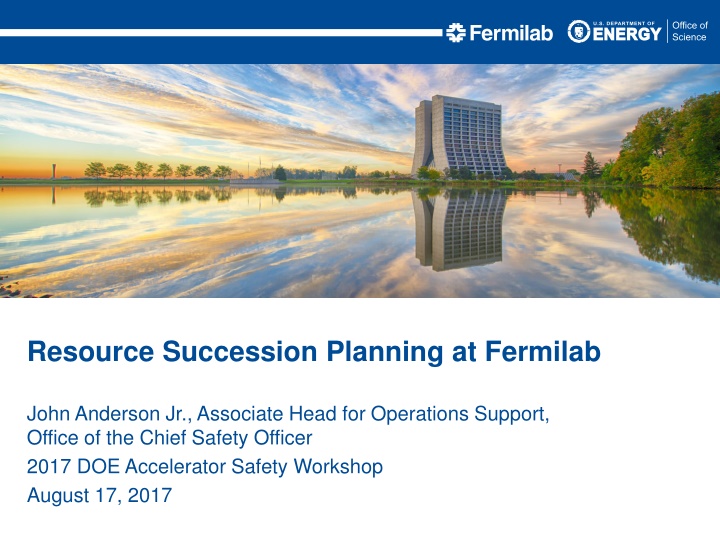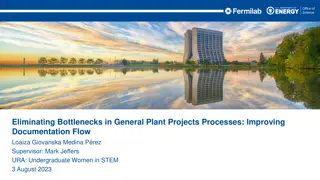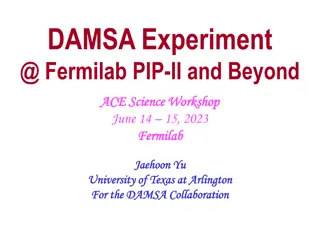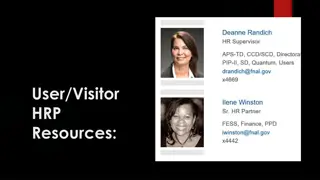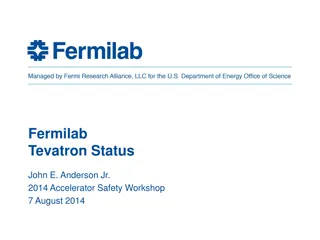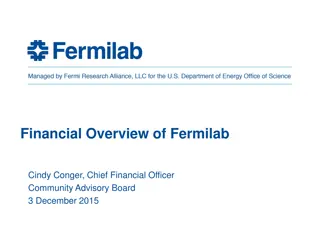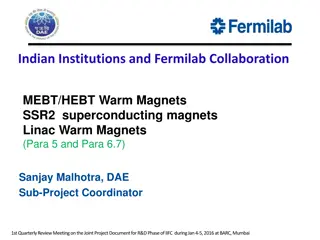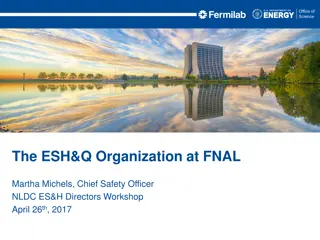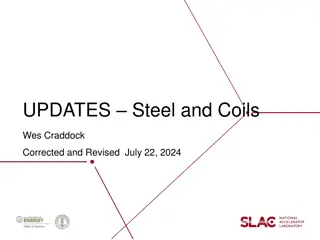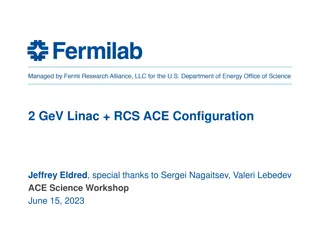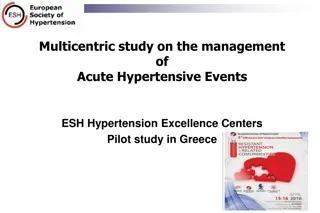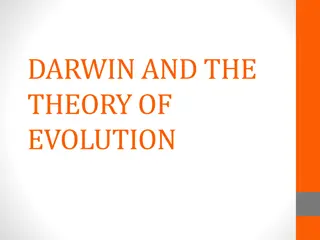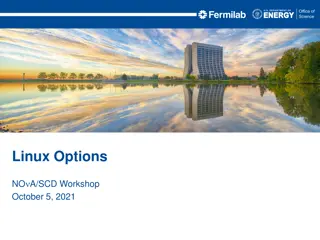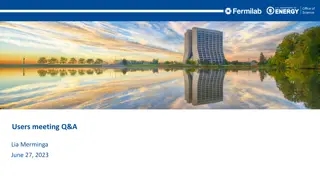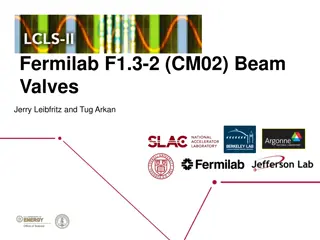Evolution of ESH&Q at Fermilab: A Comprehensive Overview
Discover the evolution of Environment, Safety, Health, and Quality (ESH&Q) practices at Fermilab under the leadership of John Anderson Jr. Learn about the establishment of clear goals, roles, and responsibilities, the implementation of efficient processes, and the development of sustainable programs. Explore the history of ESH&Q at Fermilab, from decentralized structures to centralized systems, and understand the organizational structure effective June 1, 2016.
Download Presentation

Please find below an Image/Link to download the presentation.
The content on the website is provided AS IS for your information and personal use only. It may not be sold, licensed, or shared on other websites without obtaining consent from the author.If you encounter any issues during the download, it is possible that the publisher has removed the file from their server.
You are allowed to download the files provided on this website for personal or commercial use, subject to the condition that they are used lawfully. All files are the property of their respective owners.
The content on the website is provided AS IS for your information and personal use only. It may not be sold, licensed, or shared on other websites without obtaining consent from the author.
E N D
Presentation Transcript
Resource Succession Planning at Fermilab John Anderson Jr., Associate Head for Operations Support, Office of the Chief Safety Officer 2017 DOE Accelerator Safety Workshop August 17, 2017
ESH&Q at FNAL whats included? The ESH&Q Section provides subject matter experts, oversight and lab wide programs in several functional areas delivering essential core operational support services. These areas include: Radiological Protection o Accelerator Operations Support o Shielding Assessments o Radiological Instrumentation o Radiation Safety Interlock Systems o Routine Radiation Protection Functions Construction / Occupational Safety Environmental Protection Industrial Hygiene Fire/Electrical Safety Support for Divisions and Sections Support for Projects Emergency Planning Medical Surveillance Fire Department Communications Center Security Department Quality Assurance Lab wide ESH training ESH&Q Communication Hazardous Waste Control 2 8/17/2017 John Anderson Jr. | ASW 2017
How ESH&Q evolved at Fermilab To start, we set goals to help us move forward Developed clear roles and responsibilities (for ESHQ staff) Consistent implementation of processes and policies Stop doing things that don t add value Efficient use of resources Looking for ways to use technology to reduce work Sustainable programs that make sense Build depth in qualifications and expertise Clear succession plans for key roles These goals = lower costs and better programs 3 8/17/2017 John Anderson Jr. | ASW 2017
ESH&Q at Fermilab History Started with a small central organization and several field organizations embedded in the operating divisions This worked during the Tevatron era but led to inconsistent expectations and inconsistent approaches to program implementation There was also confusion about who had the authority for ESH at the laboratory May - July 2015 Chief Safety Officer position created and we largely centralized, kept some staff deployed in the divisions Operational Radiological Safety and General Safety Staff June 2016 moved to complete centralization with matrixed support to the divisions and projects 4 8/17/2017 John Anderson Jr. | ASW 2017
ESH&Q Organization Effective June 1, 2016 Assessment arm of the organization Office of the Chief Safety Officer Direct support for each division, section and project Emergency Management FFM Program Support Chief Safety Officer Deputy Chief Safety Officer Associate Head for Direct Support Associate Head for Operations Support Senior Radiation Safety Officer IT Support Administrative Support Emergency Management/ Fire Protection Quality Assurance/Training Manager Radiation Physics Engineering Manager Safety and Health Manager Radiation Physics Science Manager D/S/P Direct Support Manager Radiation Safety Officers Occupational Safety Division Safety Officers Radionuclide Analysis Team Rad Control Technicians Industrial Hygiene Project Safety Support Shielding Assessment Instrumentation Team Construction Safety Fire Department Fire Chief Security Security Chief Interlocks Environmental Protection Manager Security Occupational Medicine Office Operated by: U.S. HealthWorks EPG Communication Center Hazard Control Technology Protective Force Wellness 5 8/17/2017 John Anderson Jr. | ASW 2017
FTEs - how are we allocated Total FTEs (after reorg) = 137 this includes service contractors 41% Fire Protection / Security / Emergency Response 25% Accelerator Operations Safety (radiation protection, shielding assessments, instrumentation, interlocks) 10% Direct support to divisions, sections and projects 7% Environmental programs/compliance (includes all hazardous waste handling) 7% Occupational Safety / Construction Safety / IH 5% Quality Assurance / Training 3% Management and administration 2% Occupational Medicine Extensive crossover between the groups highlighted in blue Many serve as SMEs to address risks example, tritium management at the laboratory 6 8/17/2017 John Anderson Jr. | ASW 2017
ESH&Q at Fermilab why did we evolve to this model? Was a natural progression. Centralizing created an environment where staff must look at the bigger picture and act with the Lab s best interest in mind. Promotes alignment creating a One Vision, One Voice, One Lab philosophy The Fermi Site Office was and continues to be very supportive of this change Benefits to the program and people include: Consistency Agility Efficiency Mobility Fresh Perspectives 7 8/17/2017 John Anderson Jr. | ASW 2017
ESH&Q Program Benefits Consistency In the application of policies / processes / protocols Development of new policies now done as a team with the implementation guided by the Division / Section / Project o Previously, there was not enough of a One Lab approach. Each field unit tended to look at what was best for their Division or Section. This led to inconsistent expectations which affected the implementation of the program. Agility Able to shift resources quickly to meet the needs of the Projects, both here and off site (i.e. Sanford Underground Research Facility in South Dakota) Leveraging skills to fill gaps in expertise (i.e. ergonomics) Provides resources without the budgetary issue of who pays 8 8/17/2017 John Anderson Jr. | ASW 2017
ESH&Q Program Benefits Efficiency We all focus on the Lab s highest priorities. Enables us to leverage tools and knowledge for consistent best practices across the lab. No more us vs. them . Reduces duplicative work across divisions and sections Aids in communication Mobility (upward and horizontal, for the ESH staff) Improves career opportunities Enhances professional development Greater exposure to peers across the organization for problem solving and sharing of best practices Increased opportunities to cross-train to improve skills and abilities Increased fairness and consistency in performance reviews and salary management Allows for on-boarding of early career talent with the ability to mentor across the organizations 9 8/17/2017 John Anderson Jr. | ASW 2017
ESH&Q Program Benefits Fresh Perspectives Created through horizontal and vertical staff rotations Horizontal rotation of staff put a new set of eyes on our operations o Rotated existing Division Safety Officers o New challenges have invigorated staff Exposed potential gaps and encouraged best practices o Found some gaps in our operations o Many best practices are being shared lab wide! Vertical rotations allowed earlier career staff an opportunity to lead and learn while their mentors are still here Helping build depth in key areas and effectively succession plan 10 8/17/2017 John Anderson Jr. | ASW 2017
ESH&Q at Fermilab Several processes have been streamlined and shared lab wide Operational Readiness Clearance (ORC) Radiation Safety IH Practices Tech (Machine) Shop Management and Training Emergency Drills Created depth in division / section experience that makes us more efficient. Much better able to cover for one another. ESH&Q took ownership of several divisionally managed programs making the management of these programs more efficient AEDs Electrical Gloves Training Costs Oxygen Monitoring 11 8/17/2017 John Anderson Jr. | ASW 2017
How did things go in the beginning? Some areas experienced a rocky start Early career staff tended to embrace the change o Viewed organizational changes as providing better opportunities Late career staff tended to be more resistant to the change o Concerns ranged from: Loss of Control Interfered with their autonomy, lost control over their work environment Uncertainty Better the devil they knew than the devil they didn t More work Change is tough and creates more work Climate of mistrust Is there a hidden agenda? Especially during tough budget climate. Performance issues with a few employees o Vocal and rebellious regarding the changes Ultimately two late career staff retired and a third transferred 12 8/17/2017 John Anderson Jr. | ASW 2017
Where are we now? ESH&Q organization is much better poised for the challenges that our current operations pose Better prepared to support the LBNF / DUNE mega project We are effective and working on becoming more efficient by Implementing additional processes (moving away from heavy expert based programs) Reengineering processes (cutting duplicative, inconsistent, and non-value added work) Better leveraging skills across the organization (empowering people) Centralized organizational model is working for us It affords us the most flexibility in an era of decreasing budgets 13 8/17/2017 John Anderson Jr. | ASW 2017
14 8/17/2017 John Anderson Jr. | ASW 2017
